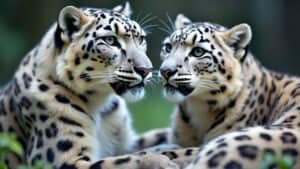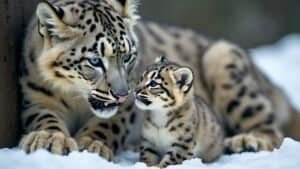Introduction
Scent marking plays a crucial role in the behavior of snow leopards, serving as a vital tool for communication, territory establishment, and social interaction. These elusive cats, found in the rugged mountains of Central and South Asia, rely on scent marks to convey information to other snow leopards about their presence, reproductive status, and territorial boundaries
This article will delve into how snow leopards use scent marking to establish and defend their territories, communicate with other individuals, and maintain their social structure. Additionally, we will explore the scientific research on scent marking and its implications for snow leopard conservation efforts
How Snow Leopards Use Scent Marking to Establish Territory
Snow leopards are solitary and elusive creatures, inhabiting the rugged, high-altitude mountains of Central and South Asia. In such vast and challenging landscapes, establishing and maintaining a territory is essential for their survival
Scent marking is one of the primary methods snow leopards use to establish and communicate the boundaries of their territories. This behavior is not only crucial for avoiding conflicts with other snow leopards but also plays a key role in their reproductive success and overall survival
Scent Marking Techniques of Snow Leopards
Snow leopards utilize various techniques to leave scent marks throughout their territories. These include rubbing their cheeks against rocks, trees, or other prominent landscape features, spraying urine on vegetation, and scraping the ground with their hind paws
Each method serves a specific purpose and conveys different types of information to other snow leopards. Cheek rubbing and ground scraping often deposit secretions from facial and interdigital glands, which contain chemical signals unique to the individual leopard
These scent marks are long-lasting and can persist for weeks or even months, making them an effective way for snow leopards to assert their presence in a given area
Urine spraying, on the other hand, is a more immediate and powerful form of scent marking. It is typically used near the edges of a territory or along well-traveled paths, where it is more likely to be encountered by other snow leopards
The chemical composition of the urine provides information about the marking individual’s sex, reproductive status, and even health, allowing other leopards to assess potential mates or rivals without direct confrontation
Territorial Boundaries and Scent Marking
The establishment of territorial boundaries through scent marking is crucial for snow leopards to avoid unnecessary conflicts and ensure access to critical resources such as food and mates
Snow leopard territories can vary greatly in size, ranging from 19 square miles to over 400 square miles, depending on prey availability and environmental conditions. Scent marking helps to delineate these boundaries, reducing the likelihood of encounters with other snow leopards that could lead to aggressive interactions
Snow leopards often renew their scent marks at regular intervals to reinforce their territorial claims. This behavior is particularly important during the breeding season when males and females become more active in marking their territories. During this time, scent marking not only serves to defend a territory but also signals reproductive readiness, attracting potential mates
In some cases, overlapping scent marks from multiple snow leopards may indicate shared use of certain areas, particularly in regions where prey is abundant and territories are smaller
Environmental Influence on Scent Marking
The effectiveness of scent marking is influenced by various environmental factors, including temperature, humidity, and the physical landscape
In cold, dry environments typical of snow leopard habitats, scent marks can last longer, allowing these solitary cats to maintain their territorial boundaries without the need for frequent remarking. However, harsh weather conditions, such as heavy snowfall or rain, can diminish the potency of scent marks, necessitating more frequent marking activity
The rugged terrain that snow leopards inhabit also plays a role in how they distribute their scent marks. These cats tend to mark prominent landscape features such as ridges, cliff edges, and well-worn trails, which are more likely to be encountered by other leopards
By marking these key locations, snow leopards can maximize the chances that their scent marks will be detected, thereby effectively communicating their presence and territorial claims to others
Scent marking is a sophisticated and adaptive behavior that allows snow leopards to navigate the challenges of their harsh environment. Through a combination of physical and chemical signals, these big cats establish and maintain their territories, ensuring their survival in some of the most remote and inhospitable regions on earth
Understanding the nuances of this behavior is not only fascinating from a biological standpoint but also essential for conservation efforts aimed at preserving these majestic animals
The Role of Scent Marking in Snow Leopard Communication
Scent marking is a key element in the communication strategies of snow leopards, allowing these solitary animals to convey vital information without the need for direct interaction
This form of communication is particularly important in the vast, rugged terrains where snow leopards live, where encounters with other individuals are rare
Through scent marks, snow leopards can share information about their identity, reproductive status, and even emotional state, all of which are critical for maintaining social order and reproductive success
Types of Scent Marks and Their Meanings
Snow leopards utilize several different types of scent marks, each carrying distinct messages. The most common types include cheek rubs, urine sprays, and ground scrapes. Cheek rubbing is typically associated with territorial marking and social communication
When a snow leopard rubs its face against a rock or tree, it leaves behind secretions from its facial glands. These secretions contain pheromones and other chemical signals that can convey information about the individual’s identity, age, and sex. This type of marking is often found at the center of a snow leopard’s territory, reinforcing their presence to any intruding leopards
Urine spraying is another crucial method, often used along territorial boundaries or on frequently traveled routes. The composition of the urine includes a complex mix of chemicals that can signal a leopard’s health, reproductive status, and dominance
For instance, a dominant male may use urine spraying to assert control over a territory and to discourage other males from entering the area. Females, on the other hand, may increase their urine marking during estrus to signal their readiness to mate, thus attracting males
Ground scraping, involving the snow leopard using its hind legs to scrape the ground and then depositing urine or glandular secretions, is another method used to communicate with other individuals. This action not only leaves a visible mark but also deposits scent in a way that can be detected by other leopards passing through the area
Ground scraping is often associated with more intense territorial disputes or mating displays, where the scent must be both strong and long-lasting to make a clear statement
Communication Through Scent: Individual and Group Dynamics
Scent marking allows snow leopards to maintain individual identity and social order without the need for direct, potentially dangerous encounters
By leaving scent marks, a snow leopard can effectively communicate its presence and status to others in the area, reducing the likelihood of territorial disputes. This is particularly important in the snow leopard’s habitat, where resources such as food and mates are often scarce and widely distributed
The communication facilitated by scent marking also plays a critical role in the reproductive dynamics of snow leopards. During the mating season, both males and females increase their scent marking activity, which serves as a form of long-distance communication
Males, in particular, may roam extensively, following scent trails left by females to locate potential mates. This system allows for the coordination of breeding activities across vast and rugged terrains, where direct contact between individuals is infrequent
In addition to individual communication, scent marking may also play a role in broader population dynamics. For example, overlapping scent marks in certain areas might indicate shared or communal territories, where multiple snow leopards coexist due to an abundance of prey
In such cases, scent marking helps to establish a social order among the individuals sharing the space, allowing them to coexist with minimal conflict
Scent Marking and Reproductive Behavior
Reproductive behavior in snow leopards is closely linked to scent marking. During the breeding season, which typically occurs in late winter, both males and females engage in heightened scent marking activity
This behavior helps to synchronize mating activities, ensuring that both partners are ready to breed at the same time. Female snow leopards in estrus leave more frequent and prominent scent marks, which act as signals to attract males from surrounding territories
Males, in turn, respond to these signals by seeking out the scent marks left by females. This can lead to intense competition among males, with scent marking playing a key role in establishing dominance
The male that can establish and maintain the most prominent scent marks in an area is often the one that secures mating opportunities with nearby females. This form of communication is critical for ensuring reproductive success in a species where individuals are widely dispersed and encounters are rare
Scent marking, therefore, is not just a territorial or communicative act but a fundamental aspect of snow leopard reproductive strategies. It enables these solitary cats to find and select mates, coordinate breeding activities, and ensure the continuation of their species across the vast and often harsh landscapes they inhabit
Scent Marking and Snow Leopard Social Structure
Snow leopards are generally solitary animals, but their social structure, although subtle and often indirect, is intricately maintained through behaviors like scent marking
This behavior allows these elusive predators to establish hierarchies, manage social interactions, and maintain a cohesive population structure without the need for frequent direct contact
Scent marking is a silent yet powerful form of communication that helps snow leopards navigate their complex social world, which is characterized by vast territories and sparse populations
Social Hierarchies and Scent Marking
In the solitary lives of snow leopards, establishing and maintaining a social hierarchy is essential for reducing conflicts and ensuring access to vital resources such as food and mates. Scent marking plays a key role in this process by allowing individual snow leopards to assert their dominance and establish their rank within a loose social order
Dominant males, for example, will often mark more frequently and over a larger area than subordinate males, thereby reinforcing their superior status. This form of chemical communication is critical in the snow leopard’s environment, where direct confrontations can be risky and energetically costly
Female snow leopards also participate in this social structuring through scent marking, particularly during the breeding season. By marking their territories, they signal their reproductive status to males while also establishing their own dominance over other females
This can help to prevent overlap in territories and reduce competition for resources among females, which is especially important in regions where prey is scarce
Interaction with Other Snow Leopards
Despite their solitary nature, snow leopards do occasionally interact with one another, particularly during the breeding season or when young leopards are still dependent on their mothers
Scent marking is crucial during these interactions, as it allows individuals to communicate without needing to come into close proximity. For example, a mother snow leopard may use scent marking to signal her presence to her cubs when she is away hunting, helping them to feel secure in her absence
Scent marking also facilitates interactions between males and females during the mating season. Males may follow the scent trails left by females in estrus, which guide them to potential mates. This system allows for mating to occur without the need for prolonged or risky encounters, which could lead to injury
Furthermore, by responding to the scent marks of other males, snow leopards can avoid direct confrontations, instead using scent as a way to gauge the strength or dominance of potential rivals
Impact of Scent Marking on Population Dynamics
The role of scent marking extends beyond individual interactions to influence the broader population dynamics of snow leopards
By establishing and maintaining territories through scent marking, snow leopards help to ensure that individuals are spaced out across the landscape, reducing competition for prey and other resources. This spacing is crucial in the snow leopard’s mountainous habitat, where prey is often dispersed and difficult to hunt
Scent marking also plays a role in the dispersal of young snow leopards as they leave their mother’s territory to establish their own
Young leopards must navigate a landscape filled with the scent marks of established adults, and these chemical cues help them avoid areas that are already claimed, reducing the risk of deadly confrontations. In this way, scent marking helps to regulate population density and distribution, ensuring that the snow leopard population remains stable and healthy across its range
Moreover, scent marking can influence the genetic diversity of snow leopard populations. By facilitating the movement of males across large distances in search of females, scent marking promotes gene flow between different groups of snow leopards
This is especially important for maintaining the genetic health of populations that are often isolated by the harsh and fragmented landscapes they inhabit
Scientific Research and Conservation Implications
The study of scent marking in snow leopards has provided critical insights into their behavior, social structure, and population dynamics. This knowledge is not only important for understanding these elusive big cats but also plays a vital role in developing effective conservation strategies
As snow leopards face numerous threats, including habitat loss, poaching, and climate change, understanding their scent marking behavior is key to preserving and managing their populations in the wild
Methods of Studying Scent Marking in the Wild
Studying scent marking in snow leopards presents significant challenges due to their elusive nature and the remote, rugged environments they inhabit. However, researchers have developed several methods to overcome these obstacles
One of the primary techniques used is the deployment of camera traps, which are strategically placed along trails, ridgelines, and other areas where snow leopards are likely to leave scent marks
These cameras can capture images and videos of snow leopards as they engage in scent marking behaviors, providing valuable data on the frequency, location, and context of these activities
In addition to camera traps, researchers also collect and analyze the actual scent marks left by snow leopards. This involves gathering samples of urine, feces, and hair from marked sites, which can then be analyzed in laboratories to identify the chemical compounds involved in scent marking
These analyses can reveal information about the individual snow leopard, including its sex, age, and reproductive status. Advances in genetic analysis have also allowed researchers to extract DNA from these samples, providing further insights into the genetic diversity and health of snow leopard populations
Radio telemetry and GPS collaring are also used to study the movement patterns of snow leopards in relation to their scent marking behavior. By tracking the movements of collared snow leopards, scientists can map out their territories and understand how scent marking helps them navigate and control their environment
This data is crucial for understanding the spatial ecology of snow leopards and how they interact with other individuals within their home ranges
Scent Marking Data and Conservation Strategies
The data collected from studies of scent marking are instrumental in shaping conservation strategies for snow leopards. By understanding how snow leopards use scent marking to establish territories and communicate, conservationists can make informed decisions about habitat protection and management
For example, identifying key areas where snow leopards frequently mark their territories can help prioritize regions for conservation efforts, such as the establishment of protected areas or wildlife corridors
Furthermore, scent marking data can inform efforts to reduce human-wildlife conflict. In areas where snow leopard territories overlap with human settlements or livestock grazing areas, understanding the boundaries of these territories through scent marking studies can help mitigate conflicts
By providing information on where snow leopards are likely to roam, conservationists can work with local communities to implement measures that protect both the snow leopards and the livelihoods of people living in these regions
Scent marking research also has implications for captive breeding and reintroduction programs. In captive environments, understanding the scent marking behavior of snow leopards can help improve the management of breeding pairs and the design of enclosures that allow these animals to express natural behaviors
For reintroduction efforts, knowledge of scent marking can assist in selecting suitable release sites and monitoring the establishment of territories by reintroduced individuals
Challenges in Snow Leopard Conservation
Despite the valuable insights gained from studying scent marking, conservation efforts for snow leopards face numerous challenges
One of the primary difficulties is the vast and inaccessible nature of snow leopard habitats, which makes it difficult to monitor populations and enforce protective measures. Additionally, the secretive and solitary nature of snow leopards means that many aspects of their behavior, including scent marking, are still not fully understood
Another significant challenge is the threat posed by climate change, which is altering the landscapes that snow leopards depend on. As temperatures rise and snowlines retreat, the distribution of prey species is changing, which in turn affects snow leopard territories and scent marking behaviors
Conservation strategies must adapt to these changing conditions, requiring ongoing research and monitoring to ensure that snow leopards can continue to thrive in their natural habitats
Poaching and illegal wildlife trade also pose severe threats to snow leopard populations. Scent marking studies have shown that territorial disruptions caused by the removal of individuals through poaching can have cascading effects on local populations
This highlights the importance of anti-poaching efforts and the need for international cooperation to combat illegal trade in snow leopard parts
Finally, the success of snow leopard conservation efforts depends on the involvement and support of local communities. Many of the regions where snow leopards live are home to indigenous peoples who rely on the same resources that snow leopards do
Balancing the needs of these communities with the protection of snow leopards is a complex challenge that requires culturally sensitive and sustainable conservation practices
Conclusion
Scent marking is a fundamental behavior in snow leopards, influencing everything from territory establishment to social interactions and reproductive success. By using various scent marking techniques, snow leopards communicate vital information across vast and rugged landscapes, helping to avoid conflicts and ensure access to resources
Understanding the complexities of scent marking is not only essential for appreciating the intricate social lives of these elusive cats but also for informing conservation strategies. As snow leopards face increasing threats from habitat loss, climate change, and poaching, research into their scent marking behavior provides crucial insights that can aid in their protection and preservation
Effective conservation efforts must continue to leverage this knowledge, ensuring that snow leopards remain a vital part of their mountain ecosystems for generations to come













